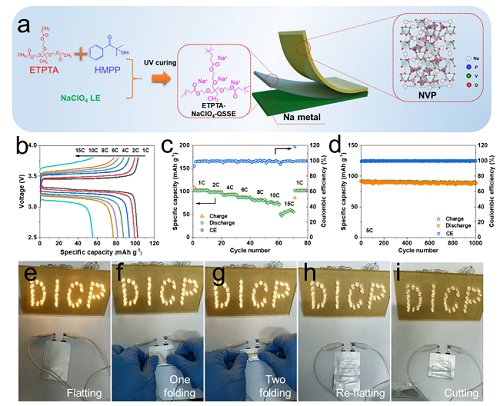Sodium (Na) has similar properties to lithium (Li), but is much more abundant and widely distributed, which makes sodium-ion batteries (SIBs) a highly competitive alternative to lithium-ion batteries (LIBs). However, the ionic radius of Na+ is larger than Li+, which is not suitable for the intercalation reaction of conventionally used graphite anode in LIBs.
As a kind of metal with high theoretical capacity and a low redox potentiais, sodium is regarded as an ideal anode material of SIBs with high output voltage and energy density. However, sodium metal batteries (SMBs) in organic electrolyte systems still suffer from serious safety issues, such as the leakage of electrolyte, and dendrite formation of Na.
Recently, a research team led by WU Zhong-Shuai from the Dalian Institute of Chemical Physics (DICP) of the Chinese Academy of Sciences developed a photopolymerized gel electrolyte with high room-temperature ionic conductivity, wide electrochemical window and excellent flexibility for ultra-high rate and ultra-long cycling sodium metal batteries.
This work was published in Advanced Energy Materials on Nov. 10.

Photopolymerized gel electrolyte with unprecedented room‐temperature ionic conductivity for high‐energy‐density solid‐state sodium metal batteries was developed (Image by WEN pengchao and HOU Xiaocheng)
"We prepared an ethoxylated trimethylolpropane triacrylate based quasisolid-state electrolyte by photopolymerization for high-energy-density solid-state SMBs," said Prof. WU.
The resulting electrolyte exhibited remarkable room-temperature ionic conductivity of 1.2 mS/cm, and provided a wide electrochemical window of > 4.7 V versus Na+/Na as well as extraordinary interfacial compatibility with Na metal anodes, effectively inhibiting the growth of Na dendrites.
Moreover, the as-assembled solid-state SMBs offered high specific capacity of 101 mAh/g at 1 C, and record rate performance at room temperature.
This work was supported by the National Natural Science Foundation of China, National Key R&D Program of China, Natural Science Foundation of Liaoning Province, and Dalian National Laboratory For Clean Energy (DNL), CAS, etc. (Text by WEN pengchao and HOU Xiaocheng)